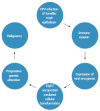Role of human papillomavirus in oropharyngeal squamous cell carcinoma: A review
- PMID: 24945004
- PMCID: PMC4061306
- DOI: 10.12998/wjcc.v2.i6.172
Role of human papillomavirus in oropharyngeal squamous cell carcinoma: A review
Abstract
Human papillomavirus (HPV) has been implicated in the pathogenesis of a subset of oropharyngeal squamous cell carcinoma. As a result, traditional paradigms in relation to the management of head and neck squamous cell carcinoma have been changing. Research into HPV-related oropharyngeal squamous cell carcinoma is rapidly expanding, however many molecular pathological and clinical aspects of the role of HPV remain uncertain and are the subject of ongoing investigation. A detailed search of the literature pertaining to HPV-related oropharyngeal squamous cell carcinoma was performed and information on the topic was gathered. In this article, we present an extensive review of the current literature on the role of HPV in oropharyngeal squamous cell carcinoma, particularly in relation to epidemiology, risk factors, carcinogenesis, biomarkers and clinical implications. HPV has been established as a causative agent in oropharyngeal squamous cell carcinoma and biologically active HPV can act as a prognosticator with better overall survival than HPV-negative tumours. A distinct group of younger patients with limited tobacco and alcohol exposure have emerged as characteristic of this HPV-related subset of squamous cell carcinoma of the head and neck. However, the exact molecular mechanisms of carcinogenesis are not completely understood and further studies are needed to assist development of optimal prevention and treatment modalities.
Keywords: Head and neck; Human papillomavirus; Oncology; Oropharyngeal; Oropharynx; Squamous cell carcinoma.
Figures
References
-
- Ferlay J, Shin HR, Bray F, Forman D, Mathers C, Parkin DM. Estimates of worldwide burden of cancer in 2008: GLOBOCAN 2008. Int J Cancer. 2010;127:2893–2917. - PubMed
-
- O’Regan EM, Toner ME, Smyth PC, Finn SP, Timon C, Cahill S, Flavin R, O’Leary JJ, Sheils O. Distinct array comparative genomic hybridization profiles in oral squamous cell carcinoma occurring in young patients. Head Neck. 2006;28:330–338. - PubMed
-
- zur Hausen H. Human papillomaviruses and their possible role in squamous cell carcinomas. Curr Top Microbiol Immunol. 1977;78:1–30. - PubMed
Publication types
LinkOut - more resources
Full Text Sources
Other Literature Sources
Research Materials



